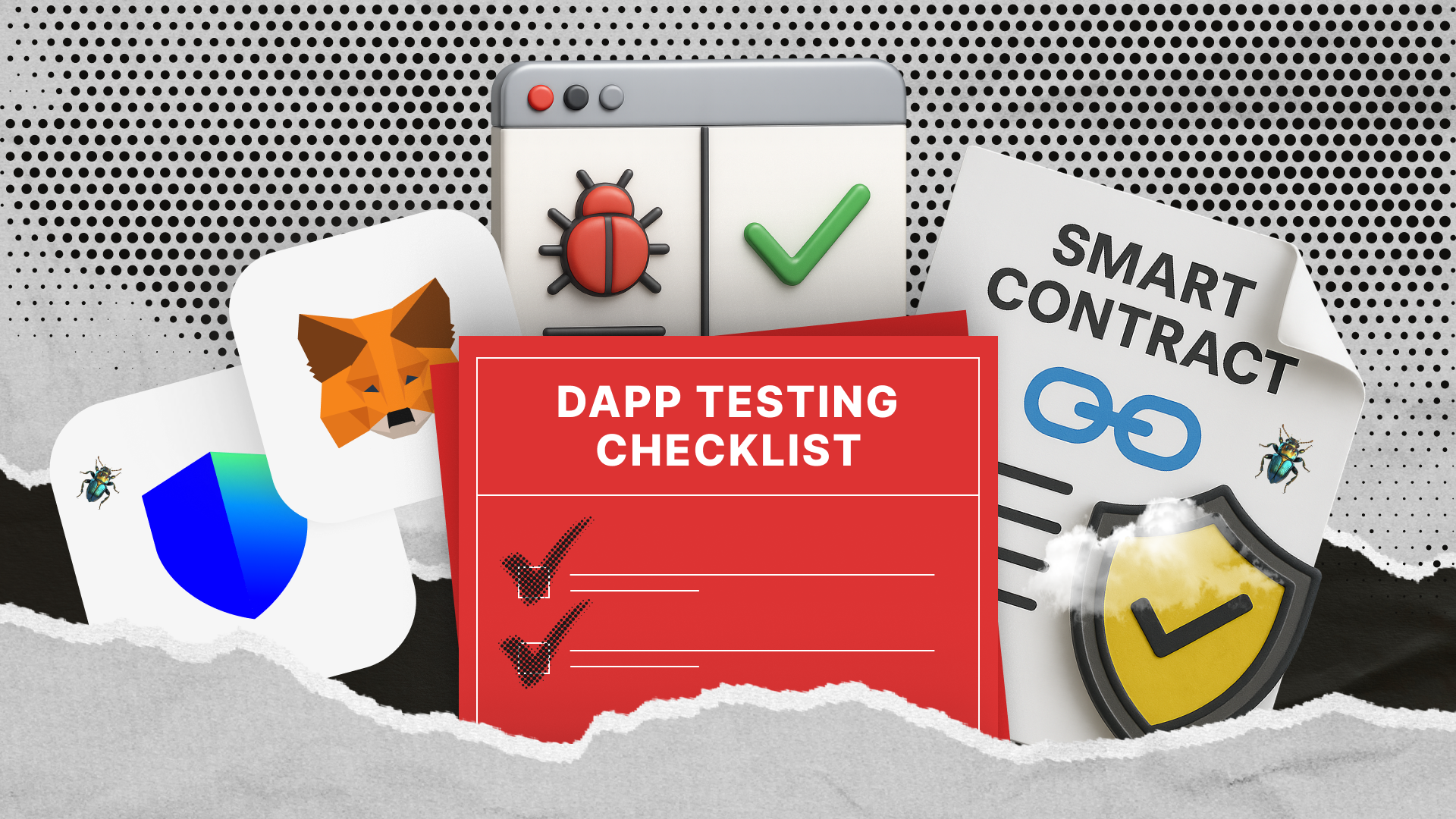Unlike traditional software, decentralized applications (Dapps) have unique security risks and challenges. Their core smart contracts are vulnerable to exploitation without thorough testing, and their decentralized nature attracts malicious actors. Recognizing these critical issues and having a robust testing strategy is essential for the security, reliability, and performance of your Dapp.
This article presents a comprehensive Dapp testing checklist that will guide you through key steps to identify and mitigate potential vulnerabilities effectively. Doing so’ll fortify your product, cultivate user trust, and establish your reputation as a secure decentralized application.
Preparation Phase of Secure Dapp Development
Establishing a robust foundation is paramount before embarking on comprehensive testing. This initial phase lays the essential groundwork for ensuring the security and reliability of your decentralized application.
- Define Testing Objectives: Delineate the key functionalities and critical aspects of your Dapp that require thorough examination. These functionalities include (but are not limited to) the underlying smart contracts, the user-facing front end, any supporting back-end infrastructure, security protocols, performance benchmarks, usability considerations, and compliance standards.
- Set Up the Testing Environment: Construct a dedicated testing environment that accurately mirrors your production deployment. This environment should encompass access to relevant blockchain testnets, appropriate cryptocurrency wallets for interaction, and all necessary supporting tools for monitoring and analysis.
- Assemble a Proficient Testing Team: The intricacies of Dapp development demand a testing team with specialized expertise in both blockchain technology and decentralized application testing methodologies. Ensure your team possesses the requisite skills and knowledge.
- Prepare Testing Tools and Frameworks: Select and configure the appropriate tools and development frameworks that are tailored to Dapp testing. Frameworks such as Truffle and Hardhat are useful for innovative contract testing and deployment, while other specialized tools are beneficial for front-end testing, performance analysis, and security scanning.
Basic Dapp Testing Areas
We organized the following checklist based on the key components and fundamental testing types essential for ensuring the security and reliability of your decentralized application.
Smart Contract Testing
Smart contracts form the core logic of your Dapp, so thoroughly testing them is a vital step.
- Unit Testing: Conduct comprehensive unit tests to verify the correctness of individual functions within your smart contracts. Unit testing ensures each function behaves as expected in isolation. This testing involves testing various inputs, such as edge cases and invalid data.
- Integration Testing: Rigorously test the interactions between smart contracts within your Dapp. Also, simulates complex transactions involving multiple contracts. These simulations will help you ensure seamless integration and accurate data flow.
- Functional Testing: Validate that the core business logic embedded within your smart contracts functions as intended. This validation includes verifying the accuracy of calculations, the correct handling of user interactions, and the contract’s response to state changes throughout its lifecycle.

- Security Testing: Employ various techniques to identify and mitigate your smart contracts’ vulnerabilities. You can scan for reentrancy attacks, integer overflows, and access control weaknesses. Utilize both automated tools and manual code reviews.
- Gas Optimization: Analyze and optimize your smart contract code for efficient gas use. The code optimization reduces users’ transaction costs and minimizes the Dapp’s operational overhead on the blockchain network.
- Formal Verification: Consider employing formal verification methods for high-stakes applications where security is critical. Use mathematical techniques to prove the correctness of your smart contract code against its specifications.
Front-End Testing
The user interface is the primary point of interaction for users of your Dapp. Ensuring its integrity and usability is crucial for providing a positive user experience and fostering trust.
- User Interface (UI) Testing: Verify that all visual elements of a Dapp render correctly across various devices and screen sizes. Check responsiveness and maintain visual consistency following design specifications.

- Functional Testing: Validate the core functionalities of the front end, including user flows, accurate display of data retrieved from smart contracts, and correct handling of user interactions with these contracts.
- Cross-Browser and Wallet Compatibility Testing: Ensure seamless compatibility and consistent performance of your Dapp across popular web browsers (e.g., Chrome, Firefox, Safari) and widely used cryptocurrency wallets (e.g., MetaMask, Trust Wallet).
- Usability Testing: Conduct thorough usability testing to assess the ease of use and overall user experience of your Dapp. Identify and address potential usability issues to ensure a smooth and intuitive interaction for all users.

Back-End Testing
Although Dapps are inherently decentralized, some may incorporate centralized back-end components for specific functionalities or data management. Rigorous testing of these elements remains crucial for overall system integrity.
- API Testing: Validate the functionality and reliability of any centralized APIs that your Dapp utilizes. Ensure they return the correct input responses and handle edge cases appropriately.
- Database Testing: Conduct thorough database testing if your Dapp relies on a centralized database for specific functionalities such as storing user profiles or off-chain data. Verify data consistency, integrity, and the proper execution of CRUD operations.
Interoperability Testing
As the blockchain ecosystem evolves, many Dapps are designed to interact with multiple chains and protocols. Ensuring seamless and secure interoperability is crucial for expanding functionality and user reach.
- Cross-Chain Functionality: Rigorously test the Dapp’s ability to interact with other blockchains or protocols. Verify the secureness and accuracy of data transfers and assets across different network environments.
- Bridge Testing: If your Dapp utilizes blockchain bridges for transferring assets between different chains, conduct thorough testing of these mechanisms. Check that the movement of assets remains secure and reliable, without loss or duplication.
Deep Dive into Critical Testing Areas
Beyond the foundational checklist, a comprehensive Dapp testing strategy necessitates a deeper examination of specific, critical areas. The following sections will delve into key aspects, providing detailed insights and best practices for ensuring your decentralized application’s security, performance, and regulatory compliance.
Security Testing for Dapps
Given that high-value assets are often managed by decentralized applications, a robust security testing strategy is not merely advisable; it’s an absolute necessity. Proactively identifying and mitigating vulnerabilities is critical for safeguarding user funds and maintaining platform integrity. Here’s a closer look at key aspects of security testing for Dapps:
- Common Dapp Vulnerabilities: Key vulnerabilities include reentrancy attacks (mitigated through checks-effects-interactions and reentrancy guards), integer overflows/underflows (prevented by using safe math libraries), and inadequate access control (resolved with robust role-based access control and authorization checks).
- Tools and Techniques for Security Testing: Utilize static analysis tools (e.g., MythX, Slither) to scan for vulnerabilities; integrate these tools into your workflow and address the findings. Employ dynamic analysis by simulating user interactions to identify runtime issues. Conduct penetration testing by engaging security professionals for a thorough assessment.
- Importance of Third-Party Security Audits: Engage independent security experts from reputable firms for thorough audits. External auditors offer unbiased perspectives, identify overlooked vulnerabilities, enhance user trust, and improve security. Address all audit findings before deployment.
Performance Testing for Dapps
Responsive user experience is crucial for Dapps. Their decentralized nature often introduces unique performance challenges requiring thorough performance testing. Here’s what you need to consider:
- Transaction Speed: Blockchain network congestion and gas limits can influence transaction speed. Analyze and optimize your smart contract code for efficiency, consider using appropriate gas limits, and inform users about potential network congestion.
- Gas Costs: Inefficient contracts can lead to high user and gas fees. Write efficient smart contracts, avoid unnecessary computations on-chain, and provide users with estimates of transaction fees before they execute transactions.
- Network Congestion: Network congestion can affect the responsiveness and overall user experience of the Dapp. Design your Dapp to handle potential delays, consider using off-chain solutions where appropriate, and monitor network conditions to provide users with relevant information.
- Load Testing: Evaluate how the Dapp performs under expected user traffic and transaction volumes with load testing. Simulate a realistic number of concurrent users and transactions using appropriate testing tools, while monitoring key performance indicators such as response time and transaction throughput.
- Stress Testing: Stress testing is crucial for determining a Dapp’s breaking point and ability to recover from extreme conditions, ensuring scalability and stability. Push the Dapp beyond its standard operational capacity and observe its behavior, identifying potential failure points while also checking degradation and recovery.
Regulatory Considerations in Dapp Testing
For Dapps handling financial assets or personal data, regulatory compliance is crucial for building trust and ensuring long-term sustainability. Therefore, testing must include adherence to these legal frameworks. Take into account the following aspects:
- Adherence to Relevant Regulations: Ensuring compliance with relevant regulations is a necessity, as is thoroughly researching the laws applicable to your Dapp’s jurisdiction and the nature of its operations (e.g., GDPR for data privacy, AML/KYC regulations for financial activities). Implement mechanisms within your Dapp to meet these legal requirements.
- KYC/AML Compliance: To address KYC/AML, integrate identity verification processes for users engaging in financial transactions and implement transaction monitoring systems to detect suspicious activities.
- Data Privacy: Protect data privacy by establishing clear data handling policies, obtaining explicit user consent for data processing, and checking whether mechanisms are in place for users to exercise their rights regarding their data.
- Smart Contract Audits: Engage auditors with expertise in relevant legal and regulatory frameworks, as well as technical competent contract knowledge. Check if the audit scope includes a review of the smart contracts’ adherence to these regulations, and address any identified compliance issues.
Manual Testing in Dapps
Although automation offers speed and repeatability, manual testing remains key to Dapp quality. Human insight can uncover issues automation might overlook. Manual testing complements automation by providing human insight and adaptability, identifying usability issues and nuanced bugs through an end-user perspective. Types of tests suitable for manual testing are:
- Usability Testing: Assess intuitiveness and ease of use by manually navigating the interface and evaluating workflows.
- Exploratory Testing: Uncover unexpected behaviors and edge cases through open-ended testing without predefined steps.
- Wallet Integration Testing: Manually interact with various wallets to ensure seamless connection, transaction signing, and balance updates.
- User Flow Validation: Manually step through critical user journeys (e.g., token swaps, lending) to verify that they function correctly.
- Visual Inspection: Confirm correct rendering and visual consistency of UI elements across devices.
Automated Testing in Dapps
Automation testing offers significant advantages, making it indispensable for repetitive tasks and critical scenarios through it’s ability to ensure broad coverage and timely feedback. The types of tests that are ideal for automation include:
- Unit Testing: Rapidly and repeatedly verify individual smart contract functions for correctness and consistency across code changes, improving efficiency.
- Basic Functional Testing: Consistently verify core user flows and smart contract interactions, catching regressions and ensuring expected behavior under standard conditions.
- Integration Testing: Ensure consistent verification of interactions between smart contracts and components, identifying integration issues early in development.
- Regression Testing: Quickly and consistently verify that previously fixed bugs haven’t reappeared, and new changes haven’t introduced new issues after code modifications.
- Performance Testing: Consistently and repeatedly evaluate the decentralized app’s ability to handle various user loads and stress conditions, ensuring scalability and responsiveness.
Comprehensive Documentation
Often underestimated, comprehensive and up-to-date documentation is a cornerstone of any Dapp. Maintaining updated documentation ensures that developers, auditors, and users have a reliable source of information, reducing potential errors. Usually, this documentation includes detailed explanations of smart contract functionalities, API specifications, user interface guides, and architectural decisions.
Takeaways
Maintaining the security and reliability of your decentralized application is an ongoing process that demands meticulous attention at every stage of development. By implementing Dapp testing of all critical components—from smart contracts to user interfaces and external integrations—developers can identify and address potential vulnerabilities before malicious actors exploit them.
To fortify your Dapp’s defenses and minimize potential weaknesses, consider integrating essential services like security audits and performance testing into your development lifecycle. Proactively identifying vulnerabilities and optimizing performance will help you build a strong and secure Dapp solution. When exploring these opportunities to enhance your Dapp’s quality and security, remember the specialized expertise of professional Dapp testing.
Our team at QAwerk offers comprehensive testing services to ensure your application is secure, reliable, and performs optimally. Contact our specialists for guidance whenever you need to incorporate expert Dapp testing into your development process.
Discover how we bug-proofed a next-gen web3 experience platform, leading to 30K waitlisted users before their first release


